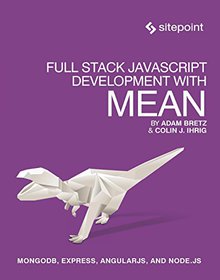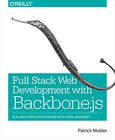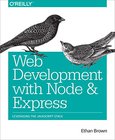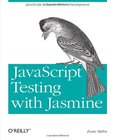Full Stack JavaScript Development With MEAN
MongoDB, Express, AngularJS and Node.JS

Book Details:
| Publisher: | SitePoint |
| Series: | Sitepoint |
| Author: | Colin Ihrig |
| Edition: | 1 |
| ISBN-10: | 0992461251 |
| ISBN-13: | 9780992461256 |
| Pages: | 300 |
| Published: | Jan 03 2015 |
| Posted: | Mar 01 2015 |
| Language: | English |
| Book format: | |
| Book size: | 4.85 MB |
Book Description:
With modern tools. it is possible to create a production grade, full-stack application using HTML, CSS, and JavaScript alone. The combination of MongoDB, Express, AngularJS, and Node.js has become so popular that it has earned the title MEAN stack -- the subject of this book.This book explores the MEAN stack in detail. We will begin by covering Node.js, as it will lay the groundwork for all of our server-side work. You will learn how to get Node running on your local machine as well as download modules using npm. The key aspects of the Node.js programming model will also be covered.From there, we will move on to MongoDB, where you'll learn how to interact with Mongo from a Node application. You will also learn how to create, retrieve, update, and delete data from a Mongo store.After you have a solid grasp on Node and Mongo, the book will move on to the Express web server. We'll cover the basics of Express applications via topics like routes and middleware. Building on previous chapters, we will cover the integration of Node, Mongo, and Express.Our coverage of the MEAN stack will wrap up with several chapters on AngularJS. These chapters will cover Angular fundamentals like data binding, directives, controllers, routing, and services. In an effort to explore competing technologies, a slight introduction to Ember.js will also be provided.Full stack JavaScript is not fully encompassed by the MEAN stack. There is an entire ecosystem of JavaScript tools to learn about, and this book will introduce a few of them. We will cover task runners Gulp.js and Grunt.js which are extremely useful for automating mundane, repetitive tasks. We'll also cover JSHint, a linting tool used to improve code quality. Linting tools analyze source code and report potentials issues - a feature that is especially useful in non-compiled languages like JavaScript.
Download Link:
Related Books:
Full Stack Web Development with Backbone.js
Learn how to build a full-stack application with Backbone.js by taking advantage of JavaScript modules, workflow automation, and Backbone's interface building blocks. With this practical guide, author Patrick Mulder takes experienced backend developers and JavaScript programmers through the steps necessary to create a fully functional single-page application.Backbone's rich ecosystem of plugins makes applications easier to design and scale, but knowing which tools to use for your project can be tricky. How do you combine views and the data layer with Backbone, or serve and deploy JavaScript assets? You'll not only learn the answers to these and many other questions; you'll also discover Backbone's vast number of use cases.Get started quickly by using...
Web Development with Node and Express
Leveraging the JavaScript Stack
Learn how to build dynamic web applications with Express, a key component of the Node/JavaScript development stack. In this hands-on guide, author Ethan Brown teaches you the fundamentals through the development of a fictional application that exposes a public website and a RESTful API. You'll also learn web architecture best practices to help you build single-page, multi-page, and hybrid web apps with Express.Express strikes a balance between a robust framework and no framework at all, allowing you a free hand in your architecture choices. With this book, frontend and backend engineers familiar with JavaScript will discover new ways of looking at web development.Create webpage templating system for rendering dynamic dataDive into request and respons...
JavaScript Testing with Jasmine
JavaScript Behavior-Driven Development
Get a concise introduction to Jasmine, the popular behavior-driven testing framework for JavaScript. This practical guide shows you how to write unit tests with Jasmine that automatically check for bugs in your application. Learn how to write specifications for individual components, and then use those specs to test the code you write. Throughout the book, author Evan Hahn focuses primarily on methods for testing browser-based JavaScript applications, but you'll also discover how to use Jasmine with CoffeeScript, Node.js, Ruby on Rails, and Ruby without Rails. You won't find a more in-depth source for Jasmine anywhere. Get an overview of both test-driven and behavior-driven development Write useful specs by determining what you need to testand what y...
2007 - 2021 © eBooks-IT.org



